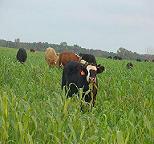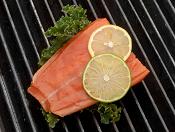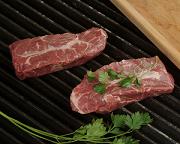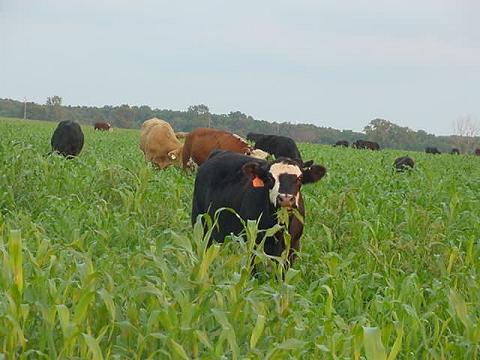Dear John,

The latest buzzword in the food is "localvore". Michael Pollen's recent book, The Omnivore's Dilemma was the start of the craze, and now we have the localvore.
Localvores promote eating only regionally, in season foods, and support the local farmers. If you have ever shopped at a farmers' market in the summer, you are taking part in being a localvore. While it seems a good idea in light of the current energy costs, there are other important things to consider such as the cost of growing or raising the food, how it is shipped, and how far the drive is to purchase the food. All of these factors enter the equation.
U.S. Wellness Meats is raised in the heartland near Monticello, Missouri. Even though this meat is shipped across the country, the energy costs to raise this naturally pastured meat is far far less than the grain-fed commercially raised meat you would find in the grocery store. In addition, U.S. Wellness ships its meat across the country in the most energy-efficient way, direct to your door. You need never get in your car to get our products.
So support your local farmers with their fresh farm produce at your local farmers' markets. Buy fresh, in season and locally grown. And save your gas and let us deliver our organic snacks, nuts, raw cheese, free range poultry, bison, and grass-fed meats right to your door!
It is hard to believe the Labor Day weekend will arrive this coming weekend. The holiday was created in 1882 by the Central Labor Union in New York City to give the "working man" a day off. Congress made it a federal holiday in 1894. The summer of 2008 flew at warp speed with copious rainfall and a panorama of growth in our pasture systems.
In honor of the occasion, we have expanded the on sale offerings to five selections. Fire up the grill and serve discounted NY strips, T-bones, burgers, and apply some good ole fashioned grass-fed butter to the late summer sweet corn.
Again, thank you for your continued patronage in a very busy 2008.
Warmest Labor Day regards,
John, Lee Ann, Megan, Mckenzie and Tressa on behalf of the farm families of U.S. Wellness Meats.
Toll Free: (877) 383-0051
URL: www.uswellnessmeats.com
email: eathealthy@grasslandbeef.com
|
BREAKING NEWS NOTES
|

RE-STOCKED ITEMS
 PROMO CODE HIDDEN IN TEXT PROMO CODE HIDDEN IN TEXT
Don't forget to look for the special promo code hidden in
the text for a one time only 15% discount off your next purchase.
First 35 users will be able to utilize the code.
The 9 red letters (in sequence) are in the extended articles in this issue and will spell out a string that can be used in the 'promo code' area when you are placing your order. The letters will begin within Catherine Ebeling article after you open the complete article. Remaining clues might be in subsequent sections of the newsletter.
This code only applies on orders weighing under 40
pounds and excludes all sale items.

..................................................................................................
MOMS NATURALLY, WE LOVE FOOD, NATURALLY!
By: Jennifer Worley & Kristen Janci
We love food! Thanks to our health-minded parents, who encouraged us to work with food, we've been cooking and baking since we were kids. We loved buying cookbooks and browsing through our Mom's recipes to choose new and interesting meals to make. We enjoyed watching our Dad's favorite cooking shows on Public Television, and over the years we've continued to adapt our ways of cooking to maintain good health. This is especially true now that we are moms.
Momsnaturally.org, launched in March of '08, grew from the desire to help other people, especially moms, learn how to enjoy cooking healthy for themselves and their families. We know time is precious, so our recipes are down to earth and relatively simple to prepare. We also realize everyone is different and tailor recipes to fit a broad range of dietary needs.
There are basic principles of health, however we understand there's not one single way to staying healthy. For instance, whole-grains are packed with nutrients, but for a person with extreme digestive disorders, they can be nearly impossible to digest. Spelt flour is a great option if you're wheat-free, but not for a person with gluten intolerances. There are many health benefits to using organic dairy products, however, someone with a dairy allergy can't benefit from cooking with them. In such cases, a different approach to staying in balance is needed.
Moms Naturally offers families recipes that are simple, healthy and taste good. And in the case of those with restricted diets, we offer healthy options that fit into their way of eating without sacrificing flavor. We also provide food tips and time savers. We include recipes for natural meats, poultry, fish and game in our Main Dish section, along with vegetarian recipes. There's a recipe for every family member here.
While we have many dessert recipes on the site, we don't advocate being out of balance in this area. The sweeteners we suggest using are naturally produced and are not bleached or stripped of their nutritional value. We promote the use of natural and organic ingredients in our recipes, and we are linked to various national and local health conscious companies. We want our readership to have access to lots of food and health related information. From where to find healthy ingredients for recipes to knowing how to join a local CSA (Community Supported Agriculture) program.
For us, Moms Naturally is a way of living. When we're sharing information with other moms, developing recipes and photographing food, it keeps us on track and reminds us that we love food, naturally.
jbw@momsnaturally.org
www.momsnaturally.org

|
GRASS-FED POWERED ATHLETE CORNER
|

Deena Kastor Bumps into Murphy's Law in Beijing
16 minutes into the ultimate race of Deena's career, she had an untimely encounter with the "sweep vehicle" that resulted in the right foot fracture of the 3rd metatarsal.
Getting used to crutches and 3 weeks of no load bearing on the right foot will require great patience for the savvy American lioness.
Leaving the marathon via medical bus was not what America's best marathoner had planned. Interestingly, Deena's career best was 5 minutes and 28 seconds under the winning time.
Once again, we see evidence that life is eerily similar to a solitaire game. However, true champions accept adversity and go on to write sequels that will inspire the world in 2012.
The folks at U.S. Wellness are anticipating much more to come based on the level of energy Deena was carrying into Beijing.
We wish you a rapid 110% recovery.

|
CATHERINE'S COMMENT
by Catherine Ebeling, RN BSN
|

WHAT IS A LOCALVORE TO DO?
The Localvore's Dilemma
The new buzzword amongst the foodies is "localvore". Yes, we know about the omnivore, and the herbivore, but what is a localvore? In the same manner as a carnivore who eats only meat, and the omnivore who eats both meat and plants, the localvore is one who eats primarily locally-grown and produced food. A localvore is a person committed to eating and learning about food grown within their own area. Localvores recognize that there are multiple benefits of eating food grown close to home. This informal movement has sprouted in the past five years in response to a food supply that has become increasingly global and sprawling.
The case for local food is several-fold: It tastes better, its proponents argue, and preserves species biodiversity. It shores up small-scale economies and communities in the face of globalization and cultural homogenization. It favors the smaller local farmers as opposed to the huge, multi-national corporations. It even, some of its advocates claim, protects against terrorism: a decentralized food system could limit the impact of a virus or other bio-agent introduced into the food supply.
One of the arguments most often heard, however, is about energy. Rising fuel costs for the transportation of food, that are now showing up as higher-priced groceries; and concern about climate change, and the great distances that most of our food travels, are a potent symbol of the system's wasteful extravagance. For the local-food activists, "food miles" have become a favored measure of environmental impact. Food activists in the U.S. and especially in Western Europe, have helped bring the term to our attention on menus and grocery-store labels.
The typical item of food on an American's plate travels some fifteen hundred miles to get there," Michael Pollan writes in "The Omnivore's Dilemma," "and is frequently better traveled and more worldly than its eater." This also highlights a more fundamental challenge for local-food enthusiasts. Michael Pollan states this challenge pointedly: "Local means local in season," he says. In most places where there are cold winters and warm summers, it means not only summers of fresh berries and arugula but January diets heavy on root vegetables and canned tomatoes. Can such a movement ever find mainstream acceptance?
Some evidence also suggests that local food can sometimes consume more energy -- and produce more greenhouse gases -- than food imported from great distances. Moving food by train or ship is quite efficient, pound for pound, and transportation can often be a relatively small part of the total energy "footprint" of food compared with growing, packaging, or, for that matter, cooking it. A head of lettuce grown locally may have less of an energy impact than one shipped up from Chile. But if that lettuce is grown late in the season in a local heated greenhouse, its energy impact goes above and beyond the imported option.
How food travels, in other words, matters as much as how far it travels, and what happens on the farm or in the kitchen can leave a much bigger energy footprint than what happens between them. Often it's those activities and behaviors at the two opposite ends of the production system that tend to dominate. Food analysts point out that, per pound of food, the grocery shopper's drive home from the store or farmer's market can often use more energy than the entire rest of the supply chain.
And for cattle, the greatest climate impact comes from the energy required to raised the feedstuffs, transport the animal to feedlots, energy to deliver the daily groceries and the infrastructure to maintain feedlots and etc. The June 2004 National Geographic Magazine highlighted a 1250 grand champion steer at the Ohio State Fair. This champion animal enlisted the support of 284 gallons of crude oil to reach market weight for the goods and services it required. Grass-fed offers an interesting alternative for a growing niche market.
Traditionally, all beef was grass-fed beef till the end of WWII, but in the United States today what is commercially available is almost all feedlot beef. The reason? It's faster, and more profitable. Seventy-five years ago, steers were traditionally 3 years old at slaughter. Today, they average 14 month with good management. You can't take a beef calf from a birth weight of 80 pounds to 1,200 pounds in a little more than a year on grass. It takes enormous quantities of grain, protein supplements, antibiotics and growth hormones.

Switching a cow from grass to grain (starch) is so disturbing to the animal's digestive system that it can kill the animal if not done gradually over 3 weeks. Low dose antibiotics are used to protect the liver from the large swing in rumen pH from pH 7 in the grazing animal to the starchy grain rumen pH that is very acidic. These animals are designed to consume forage, but we make them eat grain, primarily corn, in order to make them achieve market weight as fast as possible.
Something important to consider: cattle fed solely on grass digest their food far more efficiently and easily since grass is the cow's natural diet. Cattle fed grain are continually challenged by the pH impact of the heavy starch intake. Grass-fed beef is much healthier for you, and healthier too, for the cattle, as well as the environmental advantages for the landscape.
There are also decided environmental benefits to grass-fed beef. According to David Pimentel, a Cornell ecologist who specializes in agriculture and energy, the corn we feed our feedlot cattle accounts for a staggering amount of fossil fuel energy. Growing the corn used to feed livestock in this country takes vast quantities of chemical fertilizer, which in turn takes vast quantities of oil. Because of this dependence on petroleum, Pimentel says, a typical steer will in effect consume 284 gallons of oil in his lifetime. Comments Michael Pollan, "We have succeeded in industrializing the beef calf, transforming what was once a solar-powered ruminant into the very last thing we need: another fossil-fuel machine."
In addition to consuming less energy, grass-fed beef has another environmental advantage - it is far less polluting. The animals' wastes drop onto the land, becoming nutrients for the next cycle of crops. In feedlots and other forms of factory farming, however, the animals' wastes build up in enormous quantities, becoming an environmental challenge to return the nutrients back to soil in a smart manner.
From a humanitarian perspective, there is yet another advantage to pastured animal products. The animals themselves lead a controlled free range lifestyle where they are strategically moved to fresh grass paddocks daily. This method allows the animals to optimize growth and lets the landscape recover brilliantly during 30 to 45 rest recovery periods.
So grass-fed, even if you live in the middle of the city and there are no green pastures filled with cattle near you, is best and the most energy efficient of meats. You can get grass-fed frozen meats, fresh beef cuts twice monthly, grass-fed veal, pre-cooked entrees, raw grass-fed cheeses, grass-fed butter, organic snacks, and more, delivered to your door, frozen or fresh in a matter of a day or two. No running around in your car, burning up gas to drive to your local grocery store or farmers' market, just plain, easy, and simple. Grass-fed, the most energy-efficient of meat choices.

So in the case of vegetables and fruits, local is often best--if grown in season, and grown naturally. Otherwise it may make more sense to purchase a sustainable food from another source, as in the case of naturally raised, grass-fed meats vs. commercially raised meats.
Eating locally, or eating naturally is more sustainable, in most cases. In the context of peak oil, a looming energy crisis, and a potential food crisis by 2020, it is essential that we work towards a more sustainable community. In the same vein, eating naturally also creates a self-sufficient community. When our community becomes more self-reliant, we are less vulnerable to being manipulated by big food corporations, the federal government, and market pressures.
Eating locally is a great way to get connected with the land. By eating with the seasons, we are eating foods when they are at their peak taste, are most abundant, and the least expensive. By eating naturally, we are consuming less energy. So while all food that we may be eating may not be local, naturally produced is the most energy efficient.
Ultimately, people find fulfillment through activities that build community - and what better way to bring people together than food?

|
DR. AL SEARS, M.D.
|

Enjoy Your Steak Medium-Rare
Al Sears, MD
Author of The Doctor's Heart Cure
Do you like your steak red in the middle? I do.
Conventional wisdom says that's "dangerous," so let me put your mind at ease. The idea that it's "healthier" to cook meat until it's dry and tasteless is not based on scientific fact. Overcooking denatures protein, breaks down vitamins, and removes nutrients.
Many high-temperature cooking methods trigger a chemical change called glycation (the binding of glucose molecules to protein). Glycation is what happens to the proteins in your body as you age, and it's the same process that turns a turkey's skin brown and crispy when you cook it.
The result of glycation on meat is a spoiled protein assembly with glycotoxins. As the glycotoxins accumulate in your cells, they send out chemical signals. Your body responds by producing inflammation that can cause arthritis, cancer, diabetes, and heart disease.
You can reduce the number of glycotoxins in your food by cooking it more slowly at a lower heat - in other words, by steaming, stewing, boiling, and poaching instead of frying, broiling, and microwaving.
Marinating meat well before you cook it will also lessen glycation.

|
| Shane Ellison M.S., The People's Chemist |

SHOULD I VACCINATE MY CHILD?
By Shane "The People's Chemist" Ellison
www.thepeopleschemist.com © 2008 Vaccine talk is riddled with shoddy science, emotional arguments, convoluted explanations and all out quackery. Very little common sense shines its way through the murky vaccine debate.
Rather than question the safety and efficacy of vaccines, most physicians and parents blindly "immunize" children. Rarely do they ask the lifesaving question of, "Will a vaccine protect my child?" As a pharmaceutical chemist and parent, I researched that question six years ago. The answer was an astounding no.
Vaccines are purported to work by triggering immunity. It is "thunk" by the experts that by exposing our immune system to weak or dead infectious agents, such as measles or a flu virus, that it creates the appropriate immune defense. This logic has been used to defend the use of every vaccine to date. Yet, each vaccine has proven that the theory is nothing more than mental euphoria for nerdy scientists; it sounds good and feels better, but it's not the real thing. At best, vaccines only temporarily boost our defenses, which hardly compensates for the myriad of potential side effects. Few people are aware of - or willing to accept - these cold, hard facts.
Polio is the most feared childhood illness. It has caused paralysis and death for much of human history. The world experienced a dramatic increase in polio cases beginning in 1910. Frequent epidemics became regular events. They were the impetus for a "Great Race" towards the development of a polio vaccine. It was developed in 1953 and an oral version soon after. Yet, unbeknownst to most, polio infection plummeted before the vaccines were introduced - thanks to better sanitation and nutrition. Good thing, because both forms were a total failure. In addition to causing the very same infection they were supposed to prevent - polio - they can also lead to sudden death and cancer.
The polio virus still exists today. But few of us suffer from it. Our protection resides in the same things that were responsible for its decline; a healthy immune system courtesy of proper sanitation and nutrition.
This same scenario was repeated in the case of the whooping cough (pertussis) vaccine. Between the years of 1900 and 1935, mortality rates due to whooping cough dropped by 79% in the U.S. Yet, the vaccine wasn't introduced until 1940 (DTP and DTaP). Today, those most susceptible to whooping cough are the "immunized." In 2002, researchers with the Centers for Disease Control and Prevention publicly stated that "The number of infants dying from whooping cough, once a major killer of children in the United States, is rising despite record high vaccination levels in the nation."
The measles vaccine is no different. In 1957, the MMR vaccine became widely used in an effort to eradicate measles, mumps and rubella. Rather than prevent measles, it elicited a widespread epidemic. Between 1983 and 1990, there was a 423% increase in measles cases among those vaccinated. Today, the World Health Organization (WHO) actually warns that vaccinated individuals are 14 times more likely to contract this disease compared to the unvaccinated.
The Centers for Disease Control insisted that the MMR vaccine would also eliminate mumps in the US by the year 2010. Then, in 2006, the largest mumps outbreak in 20 years occurred. Among those who suffered from mumps, 63% were "immunized."
From its inception to now, the flu vaccine has proven just as worthless. In 2007, The Centers for Disease Control and Prevention (CDC) reported that the flu vaccine had "no or low effectiveness" against influenza or influenza-like illness. The analysis of data showed that the vaccine protected from zero to fourteen percent of vaccine participants.
Considering the overt failure of vaccination, the idea of main lining an ineffective and dangerous vaccine into our vulnerable children is chilling. Regardless, Big Pharma is hell bent on pushing more. Be forewarned, each and every vaccine will follow the same ineffective trend simply because they work against our immune system, not with it.
Vaccines will never be the panacea they are marketed as. Fortunately, as long as a child has proper eating and sanitation, their immune system can ward off biological threats. And in the rare case it doesn't, emergency medicine can tackle the infection. This is health made simple. But, in a society hell-bent on trading health for wealth, it is often over looked; just like the logic that teaches, "Vaccines don't protect children."
About the Author:
Ellison's entire career has been dedicated to the study of molecules; how they give life and how they take from it. He was a two-time recipient of the prestigious Howard Hughes Medical Institute Research Grant for his research in biochemistry and physiology. He is a best selling author, holds a master's degree in organic chemistry and has first-hand experience in drug design. Use his knowledge and insight to look and feel your best in 90 days with his free education series at
http://www.thepeopleschemist.com/articles.php
|
DR. ERIC SERRANO M.D., M.S., B.C.
|

This is a friendly reminder to email health and wellness questions to the email address below for Dr. Eric Serrano M.D. question and answer series.
Answers will appear in future issues of the Newsletter and News Alert. Your full name will not be displayed.
Dr. Serrano has been so kind to offer his expertise to literally any question related to health and wellness involving grass-fed meats.
Dr. Serrano has a wealth of knowledge from both his farm background, 15 years of clinical experience and an award winning professor at Ohio State Medical School. Dr. Serrano has an outstanding family practice on the outskirts of Columbus, Ohio and works with a select group of professional athletes.
Please email using the address below and place Dr. Serrano's name in the subject line. Answers will appear in future U.S. Wellness weekly publications.
Dr. Serrano is an M.D. with advance degrees in nutrition, kinesiology and wellness.
Dr. Eric Serrano M.D.
475 North Hill Road
Pickerington - OH - 43147-1157
EMAIL QUESTIONS TO: eathealthy@grasslandbeef.com
>>>>>>>>>>>>>>>>>>>>>>>>>>>>>>>>>>>>>>
Dr. Serrano,
1) Does eating of beef place an undue strain on the pancreas in its
bid to supply enough digestive enzymes for meat digestion?
2) Some people complain of being allergic to red meat, is this possible?
3) Is there a good method of preparing meat before cooking to speed up its digestion?
Thanx
G.
>>>>>>>>>>>>>>>>>>>>>>>>>>>>>>>>>>>>>>>
Dear G:
1-No, I don't think it does, although every thing is possible, and in one case it might.
A person with diabetes has a pancreas that actually doesn't work right, and if the pancreas output of insulin is low, meat can also have a secondary effect through the fat. In addition, if you are allergic to certain proteins in the meat you can get some type of allergic reaction, which will end up attacking the pancreas.
2-Goes back to question number 1. If the pancreas is working optimally and the person has been eating organic foods, vegetables, right fats, and consuming things that have enzymes like fermented foods, the person should be ok, the enzyme production should be ok, and the pancreas should be ok. If you have an allergy to milk or to any allergens it can make the pancreas work extra hard and have problems.
Sometimes I have ask patients to fast or to use only clear liquids so the pancreas can rest and recover.
3-Yes, always cook meat different ways, never use the same method so the proteins are not always damaged or denatured. If I have to pick one, I would use searing or olive oil marination, but of course if using hamburger you must cook it well, depending on your source of meat. Remember the meat is as good as the source, and the cooking will affect the quality of the meat.
Charbroiling the meat on a grill, which burns the meat on the outside, is not as healthy as a meat that is not burned.
Do not overcook your meat, and allow some redness within the meat because it will contain undenatured proteins, and intact enzymes
Good luck!
Eric Serrano
Dr. Serrano M.D. with advance degrees in nutrition, kinesiology and wellness.
Dr. Eric Serrano M.D.
475 North Hill Road
Pickerington - OH - 43147-1157
EMAIL QUESTIONS TO: eathealthy@grasslandbeef.com

|
WHAT OUR CUSTOMERS ARE SAYING
|

Dear U.S. Wellness:
Thank you for your products!
I am just a new customer and was recommended to
you by my brother.
I am so pleased with your meats, cheeses and butter...it is of the highest quality, and tastes proves it! It is amazing!
I am so satisfied and will continue to be a regular customer. I am so happy with the way you package and send out immediately!
You have a wonderful business, and I look forward to many more years with your company.
With a grateful heart,

B.F.
Virginia Beach, VA
|
| |
RECIPE CORNER
Grilled Lamb Rib Chops
|

INGREDIENTS:
- 4 lamb rib chops ( 1 inch thick)
- 2 tablespoons grass-fed butter
- chopped fresh parsley
- 1/2 teaspoon sea salt
- dash of pepper
- dash of paprika
- 1 teaspoon lemon juice
DIRECTIONS:
- trim excess fat from rib chops
- combine softened butter, parsley, salt, pepper, and paprika in a small bowl, stirring until completely combined
- stir in lemon juice
- spread butter mixture evenly over chops
- grill lamb rib chops over medium coals 5 to 6 minutes on each side or until desired degree of doneness
We welcome your favorite recipes, cooking ideas and suggestions. Please email to: caebeling@earthlink.net or jwood@marktwain.net
|

|
|
Lewis County Missouri - August 22nd
|

|
$25 DISCOUNT FOR 40 LB. INCREMENTS
|
|
Do not forget to take advantage of the 40 pound $25 discount by ordering 40 pound combinations of beef, lamb, pork, butter, goat, shrimp, bison, condiments, honey, rabbit, single item chicken selections, snack foods, pet food, and raw cheese.
This is our way of saying thank you for purchasing in volume. This can be any combination of products totaling 40 pounds and does not have to be specific to any category. Each 40 pound interval will yield the discount. For example, 80 pounds of product will yield a $50 discount and a 120 pound purchase will yield a $75 discount.
|
MINIMUM PURCHASE RULES
|
Our new format enacted in April 2005 requires a $75 minimum
purchase and a 7 pound minimum combined purchase of beef,
lamb,
pork,
nutraceuticals,
gourmet
rabbit, soap,
organic
shrimp, grass-fed
goat, grass-fed
bison, raw
cheese, single
piece poultry, and butter.
The issue is the bulk chicken and ten pound cheese bundles originate from
separate cold storage centers where those products are produced. It is not
efficient to ship one package of beef as a stand alone item when the balance of
the order originates 400 miles away.
The shopping cart will keep track and remind you if you are under the 7 pound
limit for a combination of beef, lamb, pork, raw cheese, butter, goat, shrimp,
soap and single honey bottle purchases. Red font will appear under the shopping
cart if you are under the minimum price or pound requirements.
|
CUSTOMER CHANGE CONTACT INFO LINK
|
Need to change your address information or remove yourself from our customer newsletter? Click here. After opening, enter your email address and store password and you will be able to edit your customer file.
..................................................................................
Confidentiality Guarantee
We at U.S. Wellness Meats do not sell, trade or give away any subscriber information. This isn't just an ethical commitment, it's also a legal one.
Copyright
Copyright © 2007 by U.S.Wellness Meats and Catherine Ebeling. All rights reserved. The content, design and graphical elements of this newsletter are copyrighted. Please secure written permission of the author before copying or using this material. Address: caebeling@earthlink.net or eathealthy@grasslandbeef.com
Sincerely,
John Wood
U.S. Wellness Meats
Toll Free: (877) 383-0051
|
|
|
|
|
ON SALE ITEMS
|
 |
The following delicious sale items will expire at midnight CST August 30, 2008.
|
|
|